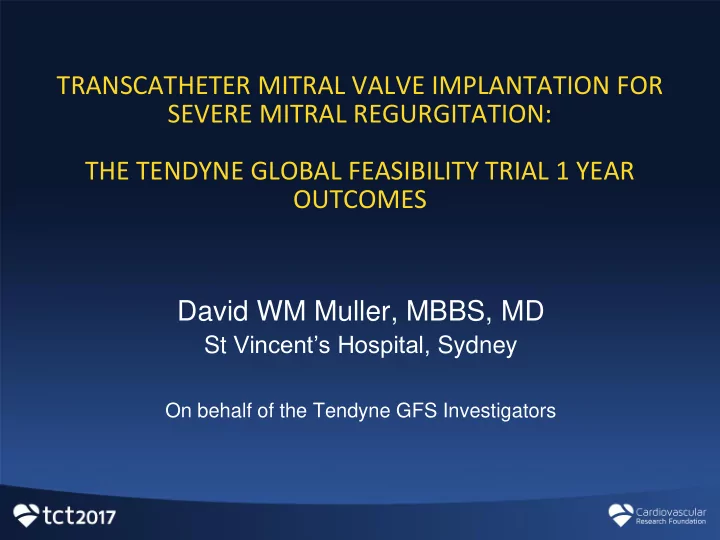

TRANSCATHETER MITRAL VALVE IMPLANTATION FOR SEVERE MITRAL REGURGITATION: THE TENDYNE GLOBAL FEASIBILITY TRIAL 1 YEAR OUTCOMES David WM Muller, MBBS, MD St Vincent’s Hospital, Sydney On behalf of the Tendyne GFS Investigators
Disclosure Statement of Financial Interest Within the past 12 months, I or my spouse/partner have had a financial interest/arrangement or affiliation with the organization(s) listed below. Affiliation/Financial Relationship Company • • Grant/Research Support Tendyne, Medtronic • • Consulting Fees/Honoraria Medtronic, Abbott, Boston Scientific, 4Tech, Cephea • • N/A Major Stock Shareholder/Equity • • N/A Royalty Income • • N/A Ownership/Founder • • N/A Intellectual Property Rights • • N/A Other
Tendyne Transcatheter Mitral Valve Tendyne Device • Tri-leaflet porcine pericardial valve • Self-expanding nitinol double frame • D-shaped outer frame, anterior cuff • Large valve size matrix • Single inner valve size • Multiple outer frame sizes • Transapical access, valve tethered to apex • Adjustable tension provides valve stability • Apical Pad assists in access closure • Valve fully retrievable and repositionable
Tendyne TMVI: Final valve deployment 3D
Tendyne TMVR GFS Investigators Global Feasibility Study (n=30) • St Vincent’s Hospital, Sydney • Abbott Northwestern, Minneapolis • Prince Charles Hosp, Brisbane • Baylor Heart and Vascular, Dallas • Oslo University Hospital, Oslo • Evanston Hospital, Chicago • Cleveland Clinic, Cleveland • Medstar Hospital, Washington DC November 2014 – March 2016
Tendyne Global Feasibility Study Objective Evaluate the safety, performance and usability of the Tendyne Mitral Valve System Key Outcome Measures 1. Mitral regurgitation* 2. LV function and dimensions by echocardiogram 3. Device function by echocardiogram 4. Major Adverse Events** 5. NYHA Classification 6. 6 Minute Hall Walk Test 7. Quality of Life (KCCQ) * Echo Core Laboratory: Beth Israel Deaconness MC ** Clinical Events Committee
Tendyne Global Feasibility Study Inclusion criteria: 1. Severe mitral valve regurgitation of primary or secondary etiology 2. NYHA functional class II, III or ambulatory IV 3. Age >18yrs, able to provide informed consent 4. Poor candidate for cardiac surgery as determined by the Heart team (including Cardiologist and Cardiac Surgeon) Exclusion criteria: 1. Severe mitral annular or valvular calcification/stenosis, vegetation or mass 2. Largest annular dimension >45mm, LVEDD >70mm 3. LVEF<30%, severe TR/RV dysfunction/pulmonary HT 4. Prior aortic or mitral valve surgery 5. Small neo-LVOT (echo, CT modeling, 3D printing)
Tendyne GFS: Demographics (n=30) Age at Baseline Mean+SD 75.6+9.2 years Range 55.1-91.4 years Gender Male 25 (83.3%) Female 5 (16.7%) NYHA Functional Class II 14 (46.7%) III 16 (53.3%) IV 0 (0%) STS Score (range) 7.3+5.7 (2-16 ) Muller DW et al JACC 2017;69:381-391
Tendyne GFS: Patient Overview (n=30) Baseline Mitral Valve pathology Primary MR 3/30 (10%) Secondary MR 24/30 (80%) Mixed pathology 3/30 (10%) Baseline LV function N=29 LVEF <30% 3/29 (10.3%) LVEF 30-50% 14/29 (48.3%) LVEF>50% 12/29 (41.4%) Baseline MR severity Grade 3+ 2/29 (6.9%) Grade 4+ 27/29 (93.1%)
GFS: Subject follow-up as of 23 May 2017 N=30 Implant not successful (n=2) Death (n=5) Withdrew Consent (n=1) Missed Visit (n=0) Visit Pending (n=0) 12 Month (n=22)
Kaplan-Meier survival curve (n=30) 1.0 All-cause mortality 0.83 0.8 0.6 0.4 0.2 0.0 100 300 0 200 Days
Tendyne TMVR: 1yr outcomes Outcome N=30 Death (all cause) 5 (16.7%) Cardiac 4 (13.3%) Non-cardiac 1 (3.3%) CVA/TIA 0 (0%) Re-hospitalisation Heart failure 3 (10.0%) MV surgery 0 (0%) Valve performance (n=28) Malposition/PVL/hemolysis 1 (3.6%) Leaflet thrombosis 1 (3.6%)
MR severity 1 year post-TMVR Paired data 100% 5.3 5.3 90% 80% 94.7 94.7 89.5 70% Grade 4 60% Grade 3 50% Grade 2 40% Grade 1 30% Grade 0 20% 10% 10.5 0% Baseline 1mth 12mths 19 N: 19 19
LVEF post-TMVR Paired analysis 50 LVEF (%) 45 40 46.7 42.0 35 38.4 30 p=NS p=NS 25 20 15 10 5 0 Baseline 1mth 12mths N: 18 18 18
Functional capacity post-TMVR (n=30) NYHA Class 100% 5.0 7.1 90% 53.3 17.9 55.0 80% 70% 50.0 60% Class 4 Class 3 50% Class 2 40% Class 1 46.7 30% 40.0 20% 25.0 10% 0% Baseline 1month 12months N: 30 28 20 >1 class improvement in 60%
Quality of Life: KCCQ KCCQ in subjects with complete data at three timepoints (n=22) 120 * * vs baseline p<0.001 100 * p<0.001 80 KCCQ 60 40 20 0 baseline 30 day 12 months
Tendyne TMVR: Conclusions (n=30) Safe and effective procedure: • Retrievable, repositionable device • Predictable deployment, well tolerated • No procedural deaths or strokes Encouraging mid-term clinical and echo results: • Low one year mortality (16.7%) • Durable relief of MR (no MR in 95%) • Low need for hospitalisation for heart failure (10%) • Substantial improvements in NYHA class, QOL CE Mark Study / Expanded Global Feasibility Study enrolling
Recommend
More recommend